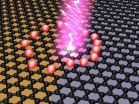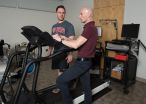Graphene pushes the speed limit of light-to-electricity conversion
Researchers from ICFO, MIT and UC Riverside have been able to develop a graphene-based photodetector capable of converting absorbed light into an electrical voltage at ultrafast timescales
2015-04-14
(Press-News.org) The efficient conversion of light into electricity plays a crucial role in many technologies, ranging from cameras to solar cells. It also forms an essential step in data communication applications, since it allows for information carried by light to be converted into electrical information that can be processed in electrical circuits. Graphene is an excellent material for ultrafast conversion of light to electrical signals, but so far it was not known how fast graphene responds to ultrashort flashes of light.
ICFO researchers Klaas-Jan Tielrooij, Lukasz Piatkowski, Mathieu Massicotte and Achim Woessner led by ICFO Prof. Frank Koppens and ICREA Prof. at ICFO Niek van Hulst, in collaboration with scientists from the research group led by Pablo Jarillo-Herrero at MIT and the research group led by Jeanie Lau at UC Riverside, have now demonstrated that a graphene-based photodetector converts absorbed light into an electrical voltage at an extremely high speed. The study, entitled "Generation of photovoltage in graphene on a femtosecond timescale through efficient carrier heating", has recently been published in Nature Nanotechnology.
The new device that the researchers developed is capable of converting light into electricity in less than 50 femtoseconds (a twentieth of a millionth of a millionth of a second). To do this, the researchers used a combination of ultrafast pulse-shaped laser excitation and highly sensitive electrical readout. As Klaas-Jan Tielrooij comments, "the experiment uniquely combined the ultrafast pulse shaping expertise obtained from single molecule ultrafast photonics with the expertise in graphene electronics. Facilitated by graphene's nonlinear photo-thermoelectric response, these elements enabled the observation of femtosecond photodetection response times."
The ultrafast creation of a photovoltage in graphene is possible due to the extremely fast and efficient interaction between all conduction band carriers in graphene. This interaction leads to a rapid creation of an electron distribution with an elevated electron temperature. Thus, the energy absorbed from light is efficiently and rapidly converted into electron heat. Next, the electron heat is converted into a voltage at the interface of two graphene regions with different doping. This photo-thermoelectric effect turns out to occur almost instantaneously, thus enabling the ultrafast conversion of absorbed light into electrical signals. As Prof. van Hulst states, "it is amazing how graphene allows direct non-linear detecting of ultrafast femtosecond (fs) pulses".
The results obtained from the findings of this work, which has been partially funded by the EC Graphene Flagship, open a new pathway towards ultra-fast optoelectronic conversion. As Prof. Koppens comments, "Graphene photodetectors keep showing fascinating performances addressing a wide range of applications".
INFORMATION:
REFERENCE
Generation of photovoltage in graphene on a femtosecond timescale through efficient carrier heating, Nature Nanotechnology.
K. J. Tielrooij, L. Piatkowski, M. Massicotte, A. Woessner, Q. Ma, Y. Lee, K.S. Myhro, C.N. Lau, P. Jarillo Herrero, N. van Hulst and F. H. L. Koppens.
DOI: 10.1038/nnano.2015.54
FUNDING INFO
This work was funded by the E.C. under Graphene Flagship, as well as an NWO Rubicon fellowship, an ICFO-Cofund fellowship, The Fundacio Cellex Barcelona, the ERC and the MIT MISTI-Spain program.
ABOUT ICFO
ICFO-The Institute of Photonic Sciences was created in 2002 by the government of Catalonia and the Technical University of Catalonia as a centre of research excellence devoted to the science and technologies of light with a triple mission: to conduct frontier research, train the next generation of scientists, and provide knowledge and technology transfer. Today, it is one of the top research centres worldwide in its category as measured by international rankings.
Research at ICFO targets the forefront of science and technology based on light with programs directed at applications in Health, Renewable Energies, Information Technologies, Security and Industrial processes, among others. The institute hosts 300 professionals based in a dedicated building situated in the Mediterranean Technology Park in the metropolitan area of Barcelona.
ICFO participates in a large number of projects and international networks of excellence and is host to the NEST program which is financed by Fundación Privada Cellex Barcelona. Ground-breaking research in graphene is being carried out at ICFO and through key collaborative research partnerships such as the FET Graphene Flagship. Prof Frank Koppens is the co-leader of the Optoelectronics work package within the Flagship program.
[Attachments] See images for this press release:

ELSE PRESS RELEASES FROM THIS DATE:
2015-04-14
Publicly funded labiaplasties in Australia and the United Kingdom have more than doubled over the last decade, leading experts will say tomorrow at the RCOG/RANZCOG World Congress in Brisbane, Australia.
In the UK, the number of labial reduction procedures has risen five-fold in the NHS over the past 10 years, with over 2,000 operations performed in 2010. In Australia, statistics published in the Medical Journal of Australia in 2011 estimated that approximately 1,500 labiaplasty and vulvoplasty operations were performed in 2010.
In a session dedicated to discussing ...
2015-04-14
Women's human rights need to be addressed globally in order to reduce maternal mortality and morbidity, says RCOG Vice President, Professor Lesley Regan, in her lecture tomorrow at the joint RCOG/RANZCOG World Congress in Brisbane, Australia.
Professor Regan's presentation 'Why mothers die: Women's human rights' focuses on the impact of human rights on women's reproductive health and the role of healthcare professionals in improving the status of women worldwide.
In 1948, the Universal Declaration of Human Rights stated that all human beings are born free and equal ...
2015-04-14
UC Davis scientists are leading three new research projects, recently funded with more than $5 million in grants from the U.S. Department of Agriculture's National Institute of Food and Agriculture.
These grants are part of USDA's $19 million effort to ensure the availability of a safe, nutritious and economically competitive food supply.
Preventing cross-contamination in produce processing:
One project will focus on preventing foodborne illnesses by developing and eventually commercializing new fresh-produce processing technologies and methods. The new systems will ...
2015-04-14
As preparations are made to observe Holocaust Remembrance Day (Thursday, April 16), a new Bar-Ilan University study reveals that the adult children of Holocaust survivors are more preoccupied with the threat of a nuclear Iran than their peers whose parents are not Holocaust survivors.
The study, entitled "Transmitting the Sum of All Fears: Iranian Nuclear Threat Salience Among Offspring of Holocaust Survivors" was published in a recent issue of Psychological Trauma, an American Psychological Association journal dedicated to the study of trauma and its aftermath.
Study ...
2015-04-14
COLUMBUS, Ohio - Exercise researchers have developed a new treadmill that automatically changes speed to match the pace of the runner.
The automated treadmill uses sonar to tell exactly where the runner is on the treadmill. If the runner picks up pace and moves toward the front of the running belt, the speed automatically increases. If the runner slows down and moves toward the back, the speed decreases.
The result is a treadmill experience that is much closer to walking or running outdoors, said Steven T. Devor, associate professor of kinesiology at The Ohio State ...
2015-04-14
Returning to everyday life and resuming work in one's regular occupation are common goals of transplant patients, yet not all who undergo lung transplantation can go back to work. In an original article in Deutsches Ärzteblatt International (Dtsch Arztebl Int 2015; 112: 213-9), Hendrik Suhling and coauthors report the findings of the first study ever performed in Germany on the percentage of lung-transplant patients who resume employment after transplantation and the reasons that keep the others from going back to work.
In a cross-sectional study, these researchers ...
2015-04-14
CAMBRIDGE, MA -- The human immune system is poised to spring into action at the first sign of a foreign invader, but it often fails to eliminate tumors that arise from the body's own cells. Cancer biologists hope to harness that untapped power using an approach known as cancer immunotherapy.
Orchestrating a successful immune attack against tumors has proven difficult so far, but a new study from MIT suggests that such therapies could be improved by simultaneously activating both arms of the immune system. Until now, most researchers have focused on one of two strategies: ...
2015-04-14
CAMBRIDGE, Mass., April 14 - A new study from the Forsyth Institute is helping to shed more light on the important connection between the mouth and heart. According to research recently published online by the American Heart Association, scientists at Forsyth and Boston University have demonstrated that using an oral topical remedy to reduce inflammation associated with periodontitis, more commonly known as gum disease, also results in the prevention of vascular inflammation and can lower the risk of heart attack.
This study is the first time researchers anywhere have ...
2015-04-14
Phoenix, AZ (April 14, 2015) - Researchers have characterized three different brain imaging changes in individuals with Down syndrome, who are at very high risk for development of Alzheimer's disease, even before the onset of progressive memory and thinking problems. Their findings could help set the stage to evaluate promising treatments to slow down or prevent the onset of Alzheimer's symptoms in these individuals, according to a study published in Alzheimer's & Dementia.
The scientists at Banner Sun Health Research Institute (BSHRI) and Banner Alzheimer's Institute ...
2015-04-14
Composite materials used in aircraft wings and fuselages are typically manufactured in large, industrial-sized ovens: Multiple polymer layers are blasted with temperatures up to 750 degrees Fahrenheit, and solidified to form a solid, resilient material. Using this approach, considerable energy is required first to heat the oven, then the gas around it, and finally the actual composite.
Aerospace engineers at MIT have now developed a carbon nanotube (CNT) film that can heat and solidify a composite without the need for massive ovens. When connected to an electrical power ...
LAST 30 PRESS RELEASES:
[Press-News.org] Graphene pushes the speed limit of light-to-electricity conversion
Researchers from ICFO, MIT and UC Riverside have been able to develop a graphene-based photodetector capable of converting absorbed light into an electrical voltage at ultrafast timescales

